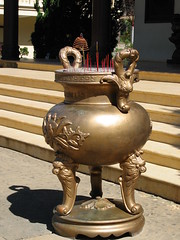In preparation to my trip to Nepal, I'd like to share with you experiments I've conducted in the previous weeks regarding GPS in n810 (thanks Nokia for selecting me in Maemo developer program, BTW) and geotagging photos.
First, some comments about GPS in n810 :
- it is a good way to learn some things about GPS technology (thanks to Wikipedia) when you want to understand why it is taking so long to get a position fix. And then, you start to speak about sky search (take about 12 minutes to download satellites constellation rough positions for your position, called almanac, valid for several weeks), cold fix (take about 6 minutes to download satellite precise position, called ephemeris, only valid 4 hours) and warm fix (take about 30s, when ephemeris is still valid in the device).
- Of course, there is no way to easy way to guess what kind of search n810 is doing when starting GPS. For the first time you use it in a geographical area, you can expect to wait for about 20 minutes. If you didn't get a GPS fix in the last 4 hours, you can expect a fix between 5 to 10 minutes. If you got a fix in the last 4 hours, you can get a fix in 30s to 1 minute (it is not impossible, I've been able to get such fast hotfix in a moving bus in Paris ;)
- You should really install Maemo-Mapper. Preinstalled software (called Maps) is a stripped version of Navicore. Unfortunately, it is barely usable, since its main goal is to see license for full version. Its main feature is using vectoral maps (so you get France maps for about 300MB) and being able to do address search offline. It is quite funny to discover it uses ogg vorbis audio files, despite no "official" support for Ogg Vorbis in IT2008 from Nokia. OTOH, Maemo Mapper, after preloading maps from either OpenStreetmap, Google, Yahoo or Virtual Earth, is way more powerful : you can easily record tracks, way points, import POI (with help of gpsbabel, you get virtually import any GPS data into Maemo Mapper).
Then, back at home, after developing Raw photos (using Ufraw), I geotagged them, using gpscorrelate and gpx track from Maemo-Mapper and pushed photos to Flickr. Et voilà : they are available on Flickr, with geo data. I've noticed a Geotag extension for F-Spot is being developed so I hope to be able to use it for my next batch of photos.

